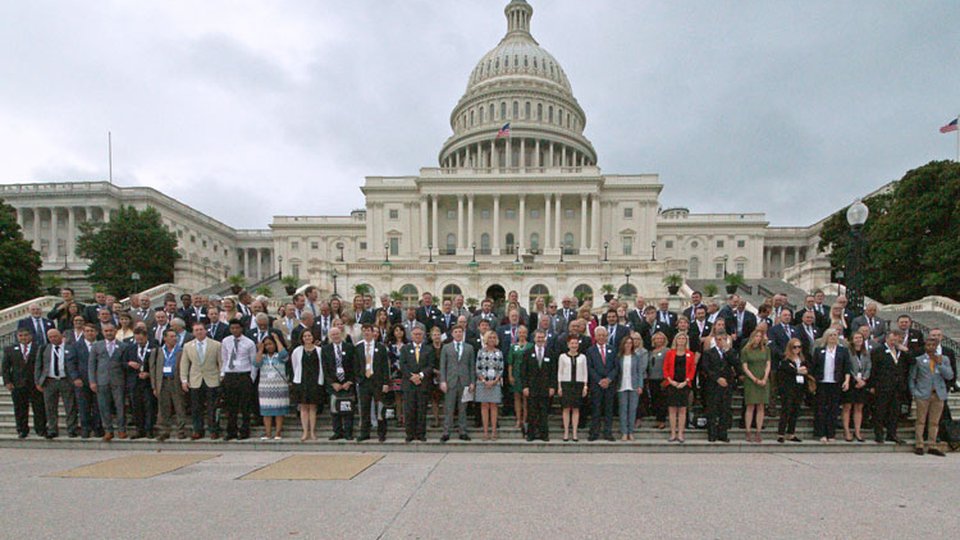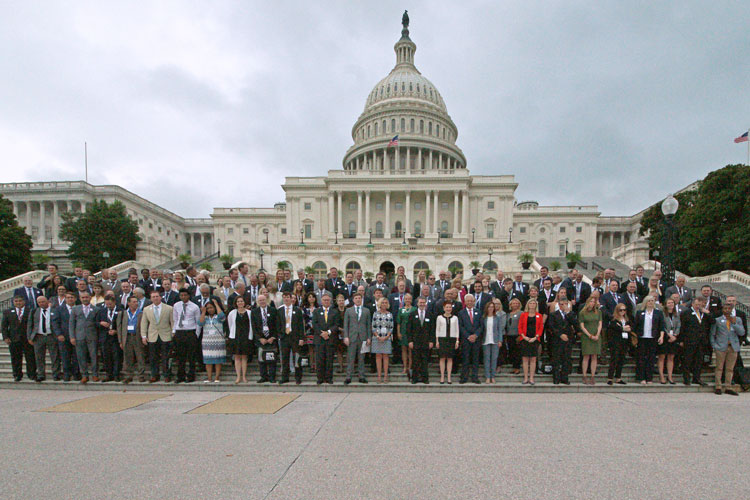News
NAMA 2018 Fly-In Focuses On Labels Federal Highway Policy
WASHINGTON, DC -- Some 300 industry members converged on the nation's capital for the National Automatic Merchandising Association's fourth annual Fly-In advocacy event. The Fly-In offers operators, suppliers and manufacturers an opportunity to visit the offices of their U.S. senators and representatives and discuss the effects of federal legislation and regulation on the industry. UNDER THE FLAGPOLE : Members of the National Automatic Merchandising Association gather on Capitol steps at start of the ass...

July 31, 2018
WASHINGTON, DC -- Some 300 industry members converged on the nation's capital for the National Automatic Merchandising Association's fourth annual Fly-In advocacy event. The Fly-In offers operators, suppliers and manufacturers an opportunity to visit the offices of their U.S. senators and representatives and discuss the effects of federal legislation and regulation on the industry.
 |
| UNDER THE FLAGPOLE: Members of the National Automatic Merchandising Association gather on Capitol steps at start of the association's annual Fly-In advocacy meeting in Washington, DC. Group then formed state delegations to visit the offices of their elected officials. |
Participants were briefed on topics of immediate and widespread interest prior to their office visits. This year's topics were the Food & Drug Administration's finalizing the specific requirements for nutritional labeling mandated by the Patient Protection and Affordable Care Act of 2010, and recent proposals to allow commercial development of rest stops on the federal interstate highway system, rescinding the preference given to blind vendors under the Randolph-Sheppard Act.
Caloric-content labeling potentially presented a costly challenge to vending operators. The industry was effective in communicating its concern to the measure's sponsors in the Senate and the House, and they responded by asking the FDA, the agency responsible for writing and enforcing the rules, to take operators' concerns into consideration as they set about their task. In the course of discussions involving all segments of the industry, the FDA agreed that vending machines that display the actual product offered for sale could meet the requirement if every selection offered carried caloric-content information on the front of the package, where consumers could see it before making their purchase. Packaged snack and confection manufacturers, many of whom already were providing this information, worked with FDA on a suitable format.
On July 12, 2018, the agency published the latest draft of its final rule, which states that the agency "would allow the vending machine operator to rely on the front-of pack calorie declaration to meet the calorie labeling requirements if the type size of the calorie declaration on the front of pack is at least 150% (one and a half times) the type size of the net weight declaration, and the front of the food package can clearly be seen through a glass front vending machine." The industry sees this as practical.
Some issues remain to be worked out, primarily regarding the small roll-candy and stick-gum packages often vended from a shallow tray mounted underneath the bottom shelf of a glassfront merchandiser. But the consensus is that final resolution is in sight. All that remains is to make sure that the product suppliers, who also are working to develop a front-of-pack nutrition facts statement format that conforms to FDA rules, are given sufficient time to redesign their packaging just once, to meet both labeling requirements – not twice in quick succession. which would be a costly waste of time and money.
Rep. Tim Walberg (R.-MI) wrote a letter to FDA commissioner Scott Gottlieb, MD, summarizing progress to date and requesting that the agency finalize the rule, and to exercise enforcement discretion at least until Jan. 1, 2020. NAMA urged its Fly-In advocates to ask their elected officials to join this letter, a copy of which (with details on joining it) was included in their information packets.
The second issue, commercialization of rest stops on the federal interstate highway system, is of great importance to the nation's blind vendors. The rules governing "safety rest stops" on interstate highways specify that nothing is to be offered for sale there except through vending machines operated by the state in which the rest area is situated. The states are allowed to contract for this vending service; priority is to be given vendors doing business under the licensing provisions of the Randolph-Sheppard Act in each state.
Recent proposals would allow commercial enterprises to bid on providing a wider range of services in rest areas in order to generate revenues for road and bridge maintenance.
NAMA's opposition to any rule change that does not preserve the blind vendors' priority is summarized in a fact-sheet that also was included in the Fly-In information packet.







